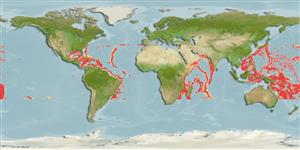>
Anguilliformes (Eels and morays) >
Synaphobranchidae (Cutthroat eels) > Synaphobranchinae
Etymology: Synaphobranchus: Greek, syn, symphysis = grown together + Greek, aphoo, aphiemi = to throw + Greek, brangchia = gill (Ref. 45335).
More on author: Günther.
Environment: milieu / climate zone / depth range / distribution range
Écologie
marin benthopélagique; profondeur 900 - 3000 m (Ref. 26895), usually 1000 - 2500 m (Ref. 58302). Deep-water; 2°C - 11°C (Ref. 26895); 37°N - 29°S
Circumtropical, except the northeast Pacific (Ref. 26895). Indo-Pacific: Zanzibar and Maldives, Japan and Australia (Ref. 7300). Western Central Atlantic: Gulf of Mexico and off Suriname (Ref. 13608).
Taille / Poids / Âge
Maturity: Lm ? range ? - ? cm
Max length : 111 cm TL mâle / non sexé; (Ref. 26895)
A benthic species (Ref. 75154) found on the continental slope (Ref. 7300, 75154).
Life cycle and mating behavior
Maturité | Reproduction | Frai | Œufs | Fécondité | Larves
Sulak, K.J. and Y.N. Shcherbachev, 1997. Zoogeography and systematics of six deep-living genera of synaphobranchid eels, with a key to taxa and description of two new species of Ilyophis. Bull. Mar. Sci. 60(3):1158-1194. (Ref. 26895)
Statut dans la liste rouge de l'IUCN (Ref. 130435)
Menace pour l'homme
Harmless
Utilisations par l'homme
Plus d'informations
Noms communsSynonymesMétabolismePrédateursÉcotoxicologieReproductionMaturitéFraiRassemblement de ponteFéconditéŒufsDéveloppement de l'œuf
Taille/Âge
Croissance
Longueur-poids
Longueur-longueur
Fréquences de longueurs
Morphométrie
Morphologie
Larves
Dynamique des populations larvaires
Recrutement
Abondance
BRUVS
RéférencesAquacultureProfil d'aquacultureSouchesGénétiqueElectrophoresesHéritabilitéPathologiesTraitementNutrientsMass conversion
CollaborateursImagesStamps, Coins Misc.SonsCiguateraVitesseType de nageSurface branchialeOtolithesCerveauxVision
Outils
Articles particuliers
Télécharger en XML
Sources Internet
Estimates based on models
Preferred temperature (Ref.
123201): 1.9 - 4.7, mean 2.8 °C (based on 3258 cells).
Phylogenetic diversity index (Ref.
82804): PD
50 = 0.5156 [Uniqueness, from 0.5 = low to 2.0 = high].
Bayesian length-weight: a=0.00071 (0.00031 - 0.00164), b=3.12 (2.92 - 3.32), in cm total length, based on LWR estimates for this (Sub)family-body shape (Ref.
93245).
Niveau trophique (Ref.
69278): 4.3 ±0.5 se; based on size and trophs of closest relatives
Résilience (Ref.
120179): Milieu, temps minimum de doublement de population : 1,4 à 4,4 années (Assuming fecundity > 100).
Fishing Vulnerability (Ref.
59153): High to very high vulnerability (67 of 100).
